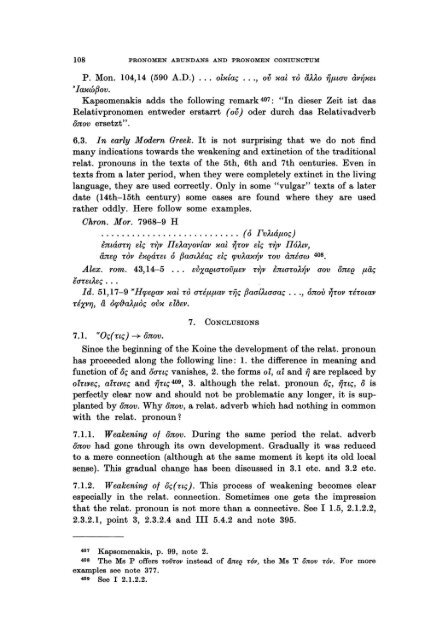Pronomen Abundans and Pronomen Coniunctum. A ... - DWC
Pronomen Abundans and Pronomen Coniunctum. A ... - DWC
Pronomen Abundans and Pronomen Coniunctum. A ... - DWC
Create successful ePaper yourself
Turn your PDF publications into a flip-book with our unique Google optimized e-Paper software.
108 PRONOMEN ABUNDANS AND PRONOMEN CONIUNCTUM<br />
P. Mon. 104,14 (590 A.D.) ... ol"taç ... , 01) "ai 'fO äAAo fjflUIV àV~"êL<br />
, Ia"áJ{Jov.<br />
Kapsomenakis adds the following remark 407: "In dieser Zeit ist das<br />
Relativpronomen entweder erstarrt (01)) oder durch das Relativadverb<br />
onov ersetzt".<br />
6.3. In early Modern Greek. It is not surprlsmg that we do not find<br />
many indications towards the weakening <strong>and</strong> extinction of the traditional<br />
relat. pronouns in the texts of the 5th, 6th <strong>and</strong> 7th centuries. Even in<br />
texts from a later period, when they were completely extinct in the living<br />
language, they are used correctly. Only in some "vulgar" texts of a later<br />
date (14th-15th century) some cases are found where they are used<br />
rather oddly. Here follow some examples.<br />
Chrono Mor. 7968-9 H<br />
. . . . . . . . . . . . . . . . . . . . . . . . . . . (ó FVAtáfloÇ)<br />
lmáa'f'YJ elç 'fT]v IIeAayovtav "ai 1}'fOV elç 'fT]V IIÓAtv,<br />
l1.nee 'fOV l"eá'fet ó {JaatAiaç elç qroAa,,~v 'fOV ànéaw 408.<br />
Alex. rom. 43,14-5 ... evxaeta'fOVfleV 'fT]V lma'fOA~V aov onee fläç<br />
la'fêLAeç . . .<br />
Id. 51,17-9 "Hrpeeav "ai 'fO aTÉflflav 'fijç {3aatAtaaaç ..., ónov 1}'fOV TÉ'fOtaV<br />
TÉxv'YJ, (i drpf}aAflOÇ ov" elóev.<br />
7.1. "Oç(nç) ~ onov.<br />
7. CONCLUSIONS<br />
Since the beginning of the Koine the development of the relat. pronoun<br />
has proceeded along the following line: 1. the difference in meaning <strong>and</strong><br />
function of 8ç <strong>and</strong> oanç vanishes, 2. the forms ol, a~ <strong>and</strong> 1} are replaced by<br />
olnveç, alnveç <strong>and</strong> fjnç 409, 3. although the relat. pronoun oç, fjnç, 8 is<br />
perfectly clear now <strong>and</strong> should not be problematic any longer, it is supplanted<br />
by onov. Why onov, arelat. adverb which had nothing in common<br />
with the relat. pronoun 1<br />
7.1.1. Weakening of onov. During the same period the relat. adverb<br />
onov had gone through its own development. Gradually it was reduced<br />
to a mere connection (although at the same moment it kept its old local<br />
sense). This gradual change has been discussed in 3.1 etc. <strong>and</strong> 3.2 etc.<br />
7.1.2. Weakening of oç(nç). This process of weakening becomes clear<br />
especially in the relat. connection. Sometimes one gets the impression<br />
that the relat. pronoun is not more than a connective. See I 1.5, 2.1.2.2,<br />
2.3.2.1, point 3, 2.3.2.4 <strong>and</strong> III 5.4.2 <strong>and</strong> note 395.<br />
407 KapBomenakiB, p. 99, note 2.<br />
408 The MB Poffers TcWTav instead of llnee TÓV, the Ms T ö:rr;ov TÓV. For more<br />
exampleB Bee note 377.<br />
40g See I 2.1.2.2.
















